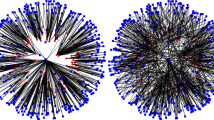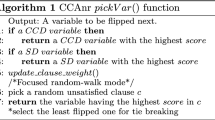Abstract
Modern SAT solvers have experienced a remarkable progress on solving industrial instances. Most of the techniques have been developed after an intensive experimental process. It is believed that these techniques exploit the underlying structure of industrial instances. However, there is not a precise definition of the notion of structure.
Recently, there have been some attempts to analyze this structure in terms of complex networks, with the long-term aim of explaining the success of SAT solving techniques, and possibly improving them.
We study the fractal dimension of SAT instances with the aim of complementing the model that describes the structure of industrial instances. We show that many industrial families of formulas are self-similar, with a small fractal dimension. We also show how this dimension is affected by the addition of learnt clauses during the execution of SAT solvers.
This research has been partially founded by the MINECO research project TASSAT (TIN2010-20967).
Access this chapter
Tax calculation will be finalised at checkout
Purchases are for personal use only
Preview
Unable to display preview. Download preview PDF.
Similar content being viewed by others
References
Albert, R., Jeong, H., Barabási, A.-L.: The diameter of the WWW. Nature 401, 130–131 (1999)
Ansótegui, C., Bonet, M.L., Levy, J.: On the structure of industrial SAT instances. In: Gent, I.P. (ed.) CP 2009. LNCS, vol. 5732, pp. 127–141. Springer, Heidelberg (2009)
Ansótegui, C., Bonet, M.L., Levy, J.: Towards industrial-like random SAT instances. In: IJCAI 2009, pp. 387–392 (2009)
Ansótegui, C., Giráldez-Cru, J., Levy, J.: The community structure of SAT formulas. In: Cimatti, A., Sebastiani, R. (eds.) SAT 2012. LNCS, vol. 7317, pp. 410–423. Springer, Heidelberg (2012)
Barabasi, A.L., Albert, R.: Emergence of scaling in random networks. Science 286, 509–512 (1999)
Kadioglu, S., Malitsky, Y., Sabharwal, A., Samulowitz, H., Sellmann, M.: Algorithm selection and scheduling. In: Lee, J. (ed.) CP 2011. LNCS, vol. 6876, pp. 454–469. Springer, Heidelberg (2011)
Katsirelos, G., Simon, L.: Eigenvector centrality in industrial SAT instances. In: Milano, M. (ed.) CP 2012. LNCS, vol. 7514, pp. 348–356. Springer, Heidelberg (2012)
Mandelbrot, B.B.: The fractal geometry of nature. Macmillan (1983)
Papadopoulos, F., Kitsak, M., Serrano, M., Bogu, M., Krioukov, D.: Popularity versus similarity in growing networks. Nature 489, 537–540 (2012)
Song, C., Gallos, L.K., Havlin, S., Makse, H.A.: How to calculate the fractal dimension of a complex network: the box covering algorithm. Journal of Statistical Mechanics: Theory and Experiment 2007(03), P03006 (2007)
Song, C., Havlin, S., Makse, H.A.: Self-similarity of complex networks. Nature 433, 392–395 (2005)
Walsh, T.: Search in a small world. In: IJCAI 1999, pp. 1172–1177 (1999)
Williams, R., Gomes, C.P., Selman, B.: Backdoors to typical case complexity. In: IJCAI 2003, pp. 1173–1178 (2003)
Xu, L., Hutter, F., Hoos, H.H., Leyton-Brown, K.: SATzilla: portfolio-based algorithm selection for SAT. J. Artif. Int. Res. 32(1), 565–606 (2008)
Author information
Authors and Affiliations
Editor information
Editors and Affiliations
Rights and permissions
Copyright information
© 2014 Springer International Publishing Switzerland
About this paper
Cite this paper
Ansótegui, C., Bonet, M.L., Giráldez-Cru, J., Levy, J. (2014). The Fractal Dimension of SAT Formulas. In: Demri, S., Kapur, D., Weidenbach, C. (eds) Automated Reasoning. IJCAR 2014. Lecture Notes in Computer Science(), vol 8562. Springer, Cham. https://doi.org/10.1007/978-3-319-08587-6_8
Download citation
DOI: https://doi.org/10.1007/978-3-319-08587-6_8
Publisher Name: Springer, Cham
Print ISBN: 978-3-319-08586-9
Online ISBN: 978-3-319-08587-6
eBook Packages: Computer ScienceComputer Science (R0)




